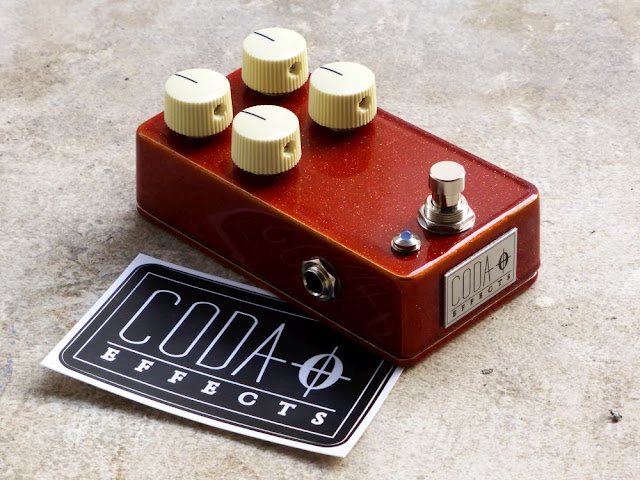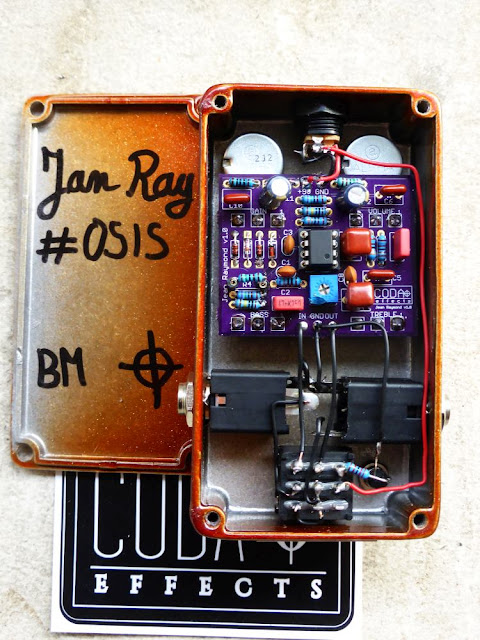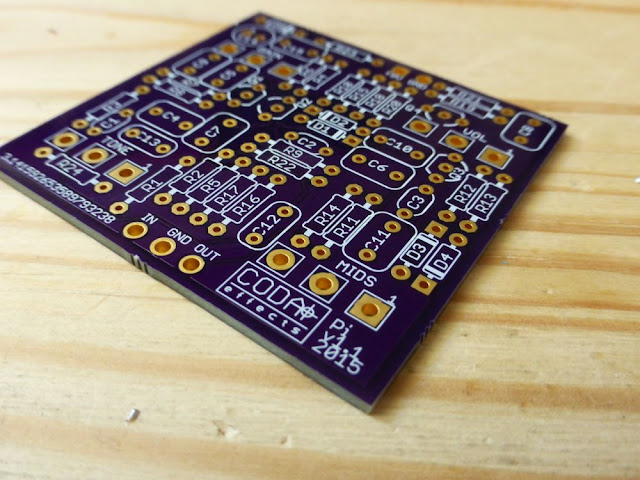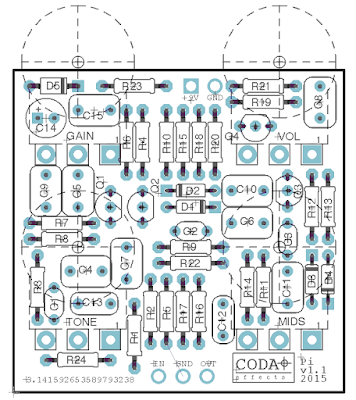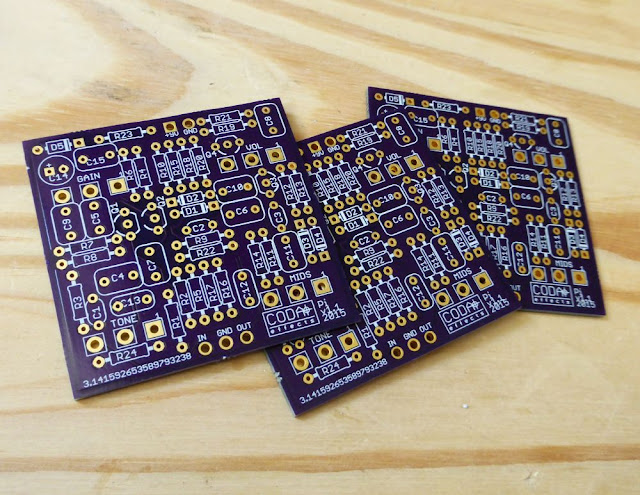Remember my Dead Astronaut Chasm Reverb PCB? I finally finished it! I left it quite a long time aside my bench, mainly because I did not have time or money to buy and build all the remaining things that needed to be done. Remember, if you want to have one, you can buy one directly from Dead Astronaut, or buy the PCB to make it yourself.
Here is my build:

As I already said before, it was a fun build to make. The PCB is quite big and components are well spaced, so it is really easy and fun to build it, even for a beginner. I had absolutely no trouble at all. I did a few mistakes with the wiring, which is not a common wiring scheme as the pedal is buffered bypass. Apart from these minor incidents, the pedal almost worked immediatly, nice!

There are four potentiometers: volume (to set the output volume), mix (allows you to mix the dry signal with the reverb signal, you can go from a 100% dry to a 100% wet signal), damp (set the overall brightness of the reverb) and decay (set the amount of reverb that goes to into a feedback loop). Indeed, one of the features that make this reverb unique compared to other Belton Bricks reverb out there is that a part of the reverb signal can go through a feedback loop, allowing the reverb to auto oscillate! The switch allows to put the reverb in auto oscillation mode.
How does it sound?
I finally invested in proper recording gear (Senheiser e906 and external audio card), so I manage to record something for you! The Chasm Reverb is a deep, spacy sounding reverb, very good sounding with a delay!The volume potentiometer is useful if you make it oscillate. At max, it is normal volume level, and you can lower it. The Mix is also quite useful, although I do not really like a too wet sound. The oscillation switch is really killer.
You can make the reverb smoother, and create "waves" of sounds, that lush for a quasi illimited amount of time! It is really awesome when combined with a delay! Perfect for ambiant stuff, and you can leave it on on the background.
Circuit analysis
Here is the circuit, from the build document:If you have already read the circuit analysis of the Rub A Dub Reverb, you can already find some similarities. As most of the DIY reverbs, it uses a Belton Brick, an IC that allows DIYers to make reverbs without having to use a spring reverb tank.
It is divided in several parts:
Let's analyze each part of the circuit.
Power supply
The power supply is a classic one that we can find in many circuits. It provides 3 different regulated tensions: 9V, 4.5V and a regulated 5V.

The Zener diode (D6) prevents polarity inversions. R22 and C16 forms a low pass filter that will eliminate any 50Hz parasitic voltage ripples remaining from your AC outlet.
R23 and R24 forms a voltage divider that provides a 4.5V tension (VB). It is regulated by C17, a 47uF capacitor that will absorb excess of voltage. This tension is necessary for the OP amps to operate correctly
Then, there is a voltage regulator, REG1, that is a 7805. "78" means that the output tension is positive, and "05" is the output tension, 5V. The regulator is necessary to supply the Belton brick a good voltage. Unregulated voltage could result in damaging the IC that is very sensitive to higher or lower voltage drops, and so requires a regulated tension provided by this small chip that look like a transistor! You will find this kind of regulators in almost every circuit using numeric IC.
JFET switching buffer
This is a peculiar switching schematic that is very pratical here because it allows the use of a buffered bypass setting that make reverb trails possible. In a true bypass setting, the reverb would be cut abruptly when the effect is turned off, whereas here it can slowly decrease

So how does it work?
First, there is an input buffer, formed with R1, C1, R2 and the first OP amp of a TL072. As you can see, there is no resistor in the loop of the OP amp, thus it has a gain of 1. It is just used to transform the low impedance signal from the guitar into a low impedance signal.
Then, ther is the proper JFET switching. Here, JFET transistors are not used like amplifiers, but rather like "on / off" switches (like in computers!). When the JFET is turned on (by supplying 9V through the DPDT switch), it allows the signal to go from the drain to the source: the signal can pass. When a JFET is on, the other is turned off, so the signal either goes to the effect, or to the buffered output. A diode prevent any parasitic signal from the gate to enter in the signal path.
This switching scheme is nice with a reverb: it diminishes "popping" issues, and allows reverb trails, which is super nice with this reverb and its auto oscillating feature.
The Reverb circuit
The reverb circuit uses the Accutronics reverb module, a great integrated circuit that I presented already in the Rub A Dub Reverb circuit analysis.
Here is a schematic of the BTDR-2H that is used in this circuit:
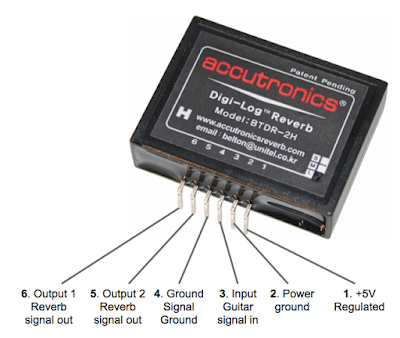
There are 6 pins on the brick. The two first ones are used for the power supply. Note that the power ground is supposed to be different than the signal ground. In some circuits, that is very important to separate digital and analog ground, and to combine them in only one point in order to diminish noise (especially if you combine digital chips with analog ones like MN3005 that are also in 5V).
The guitar signal enters in the third pin (signal ground on the 4th pin), and is "transformed" by the chip in a reverberated sound that goes out at the 5th and 6th pin. The reverbarated sound is not the dry sound + reverb sound. It is just the reverberated sound, so it is kind of peculiar. You have to mix it with the dry signal to make it sound like a reverb.
Here is the schematic of the reverb:
So first, there is a MOSFET input buffer, that increase a bit the signal. The signal is then split in two. A part of it stay dry (Dry signal part), and the other is treated by the Belton brick (reverb signal), they are mixed in the end with a mix potentiometer so you can set the amount of dry signal versus the amount of reverberated signal.
The dry signal just goes through this section without being modified, and goes to the mix knob.
The reverberated signal is buffered by an OP amp (TL072), with a gain of one (so no gain basically). A 100pF capacitors in the loop rolls off a bit of highs, and the signal can enter the BTDR2H brick. The signal then goes out from pin 5 and 6 of the reverb. The high are roll off by a low pass filter formed by the "DAMP" potentiometer and C5. For more infos about low pass filters, read my post about the Big Muff tonestack. Thus, you can set the amount of trebles in the reverbarated sound. Then, the reverbarated sound goes through an OP amp in a similar layout than at the entry. The signal then goes to the mix knob.
If that were the only features of the Chasm Reverb, this reverb would be a simple reverb with a tone control. What makes this reverb unique is its feedback loop. A part of the reverberated signal can go in the feedback loop and goes back to the entry of the reverberation circuit. The amound of signal going back to the begining of the circuit is set by the Decay knob and the switch that let you choose between a 47k resistor (a lot of signal goes back: oscillation) and a 100k one (less signal goes back: more a long-decay like reverb). This is really cool because if you set a high decay, a lot of signal can go back in the reverb circuit, and it can actually autooscillate! It also allows to approximately set the decay of the reverb, which is not possible with a standard BTDR2 brick.
After the dry and reverberated signal are mixed with the "mix" knob, there is another knob, that acts as a master volume knob. It is wired as variable resistor, and acts as a classic volume knob. The signal (reverb + dry) can now goes through the output buffer.
Output buffer
The output buffer is a simple buffer using a single OP amp from a TL072 chip.

A 100pF in the loop rolls of a bit of highs. If the pedal is off, the dry signal goes through it with a gain of 1 (resistor R16/R13), but if the pedal is on, it has a bit of gain (R15/R16) to compensate the loss of volume due to the Belton Brick, the mix and volume knobs. It is a simple buffer, very transparent because of the high values of the coupling caps (C10 and C13, 10uF) and the use of the TL072.
There it is! I hope that it is clear and that it was helpful! Do not hesitate to ask questions in the comment. If you like this post, thank me by liking Coda Effects Facebook page!
To go further
JFET switching (pdf by Geofex): great explanations about JFET switching, around the classic Boss / Ibanez circuit.
Accutronics BTDR2 official webpage.
Pedalrig tips about noise, great infos too!
Chasm Reverb official webpage, if you want to buy a built one or a PCB!




